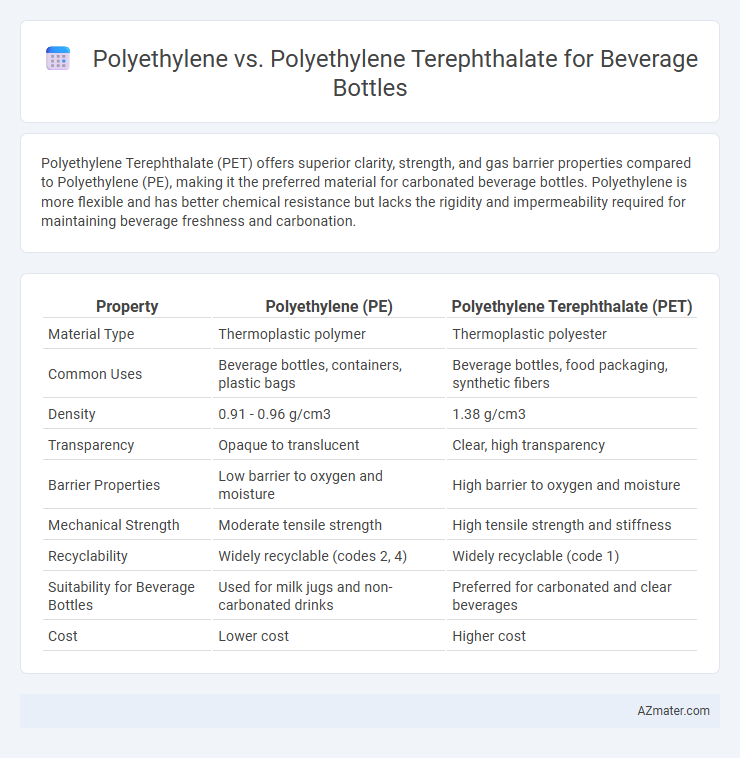Polyethylene Terephthalate (PET) offers superior clarity, strength, and gas barrier properties compared to Polyethylene (PE), making it the preferred material for carbonated beverage bottles. Polyethylene is more flexible and has better chemical resistance but lacks the rigidity and impermeability required for maintaining beverage freshness and carbonation.
Table of Comparison
| Property | Polyethylene (PE) | Polyethylene Terephthalate (PET) |
|---|---|---|
| Material Type | Thermoplastic polymer | Thermoplastic polyester |
| Common Uses | Beverage bottles, containers, plastic bags | Beverage bottles, food packaging, synthetic fibers |
| Density | 0.91 - 0.96 g/cm3 | 1.38 g/cm3 |
| Transparency | Opaque to translucent | Clear, high transparency |
| Barrier Properties | Low barrier to oxygen and moisture | High barrier to oxygen and moisture |
| Mechanical Strength | Moderate tensile strength | High tensile strength and stiffness |
| Recyclability | Widely recyclable (codes 2, 4) | Widely recyclable (code 1) |
| Suitability for Beverage Bottles | Used for milk jugs and non-carbonated drinks | Preferred for carbonated and clear beverages |
| Cost | Lower cost | Higher cost |
Introduction to Beverage Bottle Materials
Polyethylene (PE) and Polyethylene Terephthalate (PET) are two of the most commonly used polymers in beverage bottle manufacturing. PE offers excellent chemical resistance and flexibility, making it suitable for milk and juice containers, while PET provides superior clarity, strength, and barrier properties, ideal for carbonated drinks and water bottles. The choice between PE and PET depends on factors like product compatibility, durability, recyclability, and cost-efficiency in beverage packaging.
What is Polyethylene (PE)?
Polyethylene (PE) is a widely used thermoplastic polymer known for its light weight, high chemical resistance, and excellent moisture barrier properties, making it suitable for beverage bottles. It typically comes in various densities such as low-density polyethylene (LDPE) and high-density polyethylene (HDPE), both of which offer durability and flexibility essential for packaging. PE is cost-effective and recyclable, but compared to Polyethylene Terephthalate (PET), it generally provides lower clarity and gas barrier performance for carbonated beverages.
What is Polyethylene Terephthalate (PET)?
Polyethylene Terephthalate (PET) is a thermoplastic polymer resin widely used in beverage bottles due to its strong barrier properties, lightweight nature, and excellent clarity. PET offers high resistance to impact and moisture, making it ideal for preserving the carbonation and freshness of soft drinks and bottled water. Compared to polyethylene, PET provides superior gas barrier performance and recyclability, enhancing sustainability in packaging applications.
Physical Properties: PE vs PET
Polyethylene (PE) exhibits lower density, flexibility, and impact resistance compared to Polyethylene Terephthalate (PET), making PET more suitable for rigid, durable beverage bottles. PET offers superior tensile strength, higher clarity, and excellent gas barrier properties, which enhance the shelf life of carbonated drinks. The thermal resistance of PET also surpasses that of PE, allowing for safer hot-fill applications in beverage packaging.
Chemical Resistance and Safety
Polyethylene terephthalate (PET) offers superior chemical resistance compared to polyethylene (PE), with high resistance to acids, alkalis, and alcohols, making it ideal for carbonated beverages and acidic drinks. PET is also safer for beverage packaging due to its excellent barrier properties against oxygen and carbon dioxide, which helps maintain product freshness and reduces contamination risks. Polyethylene, while generally safe and inert, has lower chemical resistance and gas barrier properties, limiting its use to non-carbonated, less acidic beverages.
Manufacturing Process and Cost Comparison
Polyethylene (PE) requires lower processing temperatures and simpler molding techniques like blow molding, resulting in faster cycle times and reduced energy consumption compared to Polyethylene Terephthalate (PET). PET manufacturing involves more complex processes including injection molding, stretch blow molding, and requires higher temperature resistance, increasing production time and equipment expenses. Cost-wise, PE bottles are generally cheaper due to inexpensive raw materials and streamlined production, whereas PET bottles have higher costs driven by material properties that support better gas barrier performance and product shelf life.
Environmental Impact and Recyclability
Polyethylene Terephthalate (PET) exhibits higher recyclability rates and is widely accepted in global recycling systems compared to Polyethylene (PE), which often presents challenges due to its varying density types such as HDPE and LDPE. PET's lighter environmental footprint includes greater potential for closed-loop recycling, reducing the need for virgin fossil fuel extraction, whereas polyethylene's slower degradation and lower recycling efficiency contribute significantly to plastic pollution. The selection of PET for beverage bottles aligns with sustainability goals through enhanced recyclability and lifecycle carbon reduction when managed properly.
Performance in Beverage Storage
Polyethylene Terephthalate (PET) offers superior oxygen and moisture barrier properties compared to Polyethylene (PE), making it more effective for preserving beverage freshness and carbonation. PET's higher strength and clarity enhance product appeal while maintaining chemical resistance, preventing flavor contamination. PE, though flexible and cost-effective, has limited barrier performance, leading to potential taste alteration and shorter shelf life in beverage storage applications.
Consumer Perception and Industry Trends
Polyethylene terephthalate (PET) dominates the beverage bottle market due to its lightweight, clarity, and superior barrier properties, which consumers associate with freshness and quality. Polyethylene (PE), though valued for its flexibility and chemical resistance, is less favored in transparent packaging, influencing industry trends toward PET for carbonated drinks and bottled water. Increasing consumer demand for sustainability is driving innovation in recyclable PET and bio-based alternatives, making PET the preferred choice among manufacturers and environmentally conscious consumers.
Conclusion: Choosing the Best Material
Polyethylene terephthalate (PET) outperforms polyethylene (PE) in beverage bottle applications due to its superior clarity, strength, and barrier properties against gases and moisture, ensuring better product preservation. PET's recyclability and lighter weight contribute to environmental sustainability and reduced shipping costs compared to traditional PE bottles. For beverage manufacturers prioritizing durability, product shelf life, and eco-friendly practices, PET is the optimal material choice.

Infographic: Polyethylene vs Polyethylene Terephthalate for Beverage Bottle
 azmater.com
azmater.com